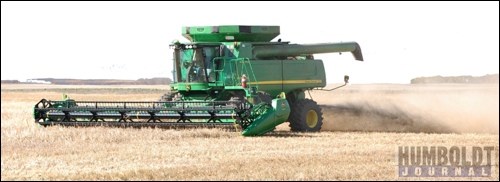There's snow on the ground and unlike last year, the long-range forecast isn't promising a change in the weather.
With this year's agriculture outlook mired in wet, muddy fields, most farmers in the greater Humboldt region managed to get their crops in. But for some, harvest was non-existent because they didn't get anything in the ground.
Saskatchewan Agriculture is reporting that 99 per cent of the crop had been harvested by November 1.
Brian Hering, who farms just north of Bruno, says his harvest was mediocre.
"I was lucky to get what I got," he said.
Hering had planted spring wheat, canola, and peas; the canola will probably give him the best return, he said.
The ground was still wet when Hering harvested, but it wasn't as bad as earlier in the year, he noted.
Hering didn't plant any winter wheat this year, but that's not unusual.
What does have Hering down is the snow and rain that has blanketed the area.
"It's kind of disappointing to see the moisture coming again this early," Hering said.
Mark Steckler, who farms just west of Colonsay, is another farmer who got his crop off before the snow. He had planted peas, lentils, wheat, oats, and canola this year, "a little bit of everything," Steckler said.
Harvest went okay and the crops were pretty good, with oats probably 小蓝视频 the best, he noted.
The wet ground was also a problem for him.
"We got stuck a few times, but not a lot," Steckler said.
Steckler doesn't usually plant winter wheat and didn't put any in this year either.
Ken Bartel farms just west of Lanigan. He only got about 20 per cent of his land seeded this year and some of that probably shouldn't have been, he said.
The lentils all went feed grade and they only ran five to 10 bushels an acre. The only bright spot was canola, which graded Number 1, he said.
The wet fields caused lots of problems, forcing Bartel to put dual tires on the combines and have tractors with towing straps out in the field at all times. As for the grain trucks, they didn't venture into the fields very far - everything was done with grain carts, Bartel explained.
Bartel finished harvest on about the second week in October, but doesn't think it looks very promising for next year.
"I think we're looking at above normal spring runoff," Bartel said.
The fields are still really wet and he wonders what this winter's moisture will do to them.
Bartel had planned to plant some grass in August, but that didn't happen because of the moisture. That actually turned out to be a good thing, as 50 per cent of the field he was looking at planting ended up 小蓝视频 under water for long enough that it probably would have drowned the grass, he said.
Bartel had also planned to plant some winter wheat, but the September rains finished that off, as well.
The amount of fall-seeded crops is down, with Sask Ag reporting that winter wheat seeded acres are down by five per cent, while fall rye seeded acres are down by 10 per cent.




